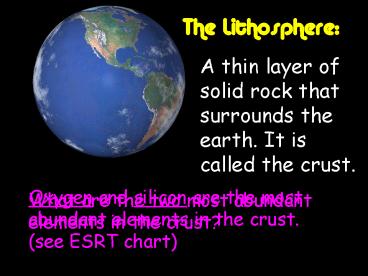The Lithosphere: - PowerPoint PPT Presentation
1 / 39
Title:
The Lithosphere:
Description:
Clastic sedimentary rocks contain tiny rock fragments. Natural Bridges, Utah 2002. What is a clastic sedimentary rock? What is a bioclastic rock? Fossil Limestone ... – PowerPoint PPT presentation
Number of Views:64
Avg rating:3.0/5.0
Title: The Lithosphere:
1
The Lithosphere
A thin layer of solid rock that surrounds the
earth. It is called the crust.
Oxygen and silicon are the most abundant elements
in the crust. (see ESRT chart)
What are the two most abundant elements in the
crust?
2
Minerals are
Naturally occurring (not man made)
Inorganic (not made from living things)
Solid
Have a specific chemical composition
Have a distinct crystal structure
3
A minerals properties are determined by the
internal arrangement of its atoms.
Both graphite and diamond are made entirely of
carbon atoms, but their atoms are arranged
quite differently.
4
Consists of one silicon atom and three oxygen
atoms.
What is the name of this structure?
It is a silica tetrahedron
It has a distinct __________shape.
triangular
5
Minerals can be identified by
Their physical and chemical properties
- Color
- Hardness
- Streak
- Luster
- Cleavage/ Fracture
- Specific Gravity
- Special Properties
On the next set of slides, try defining each
property of mineral identification.
6
Color
The actual color of the mineral.
7
Color is not good for identifying because some
minerals come in many colors.
All these minerals are quartz!
8
Hardness
Tests how a mineral can be scratched by another
object.
This is done by using the MOHS Hardness Scale
9
Streak
The color left on a streak plate when a mineral
is rubbed on it..
10
Luster
Shows how shiny a mineral is. It is considered
metallic if it shines like metal.
Galena is metallic.
Gypsum is non-metallic.
11
Cleavage
If a mineral breaks along a specific plane it has
cleavage.
Biotite splits in sheets along flat planes and
shows cleavage..
12
Fracture
If a mineral breaks unevenly or splinters it
shows fracture.
Hematite breaks unevenly.
13
Specific Gravity
This is the density of a mineral.
Iron has a higher density than Talc.
14
Special Properties
Some minerals have unique properties that help in
identification.
15
Double Refraction
Splits light to show a double image.
16
Acid Soluble
Dissolves in acid.
17
Magnetic
Shows magnetic properties.
18
Rocks that form above the surface are called
Rocks that form below the surface are called
Lava
Volcanic Rocks
Basalt Pumice Obsidian Rhyolite
Plutonic Rocks
Granite Gabbro
Magma
19
Volcanic Rocks
Plutonic Rocks
They are intrusive.
They are extrusive.
They have _______ crystals.
They have ________ crystals.
large
small
quickly
They cool _______
They cool _______
slowly
20
Igneous rocks have intergrown crystals that fit
together like a jigsaw puzzle.
Granite
21
Texture Defines the appearance of an igneous
rock.
Youre looking mighty fine baby!
Rocks can be coarse grained, fine grained or
glassy.
22
Slow cooling results in large crystals that are
visible to the eye.
Coarse
Granite
Diorite
Gabbro
23
Faster cooling results in smaller crystals that
are only visible under a microscope.
Fine Grained
Basalt
Rhyolite
Andesite
t
24
Very rapid cooling causes rocks to have a glassy
texture.
Glassy
Obsidian
25
(No Transcript)
26
How do sedimentary rocks form?
Sedimentary rock forms when sediment (pieces of
weathered rock) is compressed and cemented
together.
Bryce Canyon, Utah 2002
27
Sedimentary rocks are classified by the sediments
or fossils found in them.
28
What is a clastic sedimentary rock?
Clastic sedimentary rocks contain tiny rock
fragments.
Natural Bridges, Utah 2002
29
Bioclastic sedimentary rocks are made from broken
pieces of shells
What is a bioclastic rock?
Fossil Limestone
30
Chemical sedimentary rocks form from the
evaporation of a solution. They are also called
crystalline rocks.
How do chemical sedimentary rocks form?
Rock Salt (Halite)
31
(No Transcript)
32
Metamorphic Rocks
New rocks that have been formed from igneous,
sedimentary and other metamorphic rocks that have
been changed due to high pressure and heat.
33
Metamorhic rocks can be identified by its
foliation (the wavy banding and mineral
alignment.)
34
Foliation You can see the layers.
Gneissic texture
Banding is the alternating layers of dark and
light minerals.
What is banding?
35
Mineral alignment occurs when minerals are packed
on top of one another.
What is mineral alignment?
Schistose Mica crystals can be seen
Slatey- These crystals are so small they can not
be seen.
36
Describe how non-foliated minerals are formed.
Non-Foliation These minerals are NOT aligned.
They have undergone recrystallization.
Marble
37
Contact Metamorphism Hot magma touches existing
rock, heating and changing it. It does NOT melt
the rock!
Tick marks indicate contact
Granite
Sandstone
The metamorphic rock created will be quartzite.
Magma
38
(No Transcript)
39
Sedimentary Rock
Burial,compaction,cementation
Heat Pressure applied
Weather Erodes
Sediment
Melting
Heat Pressure
Weathers Erodes
Metamorphic Rock
Weather Erodes
Igneous Rock
Melting
Melting
Solidifies
Magma































